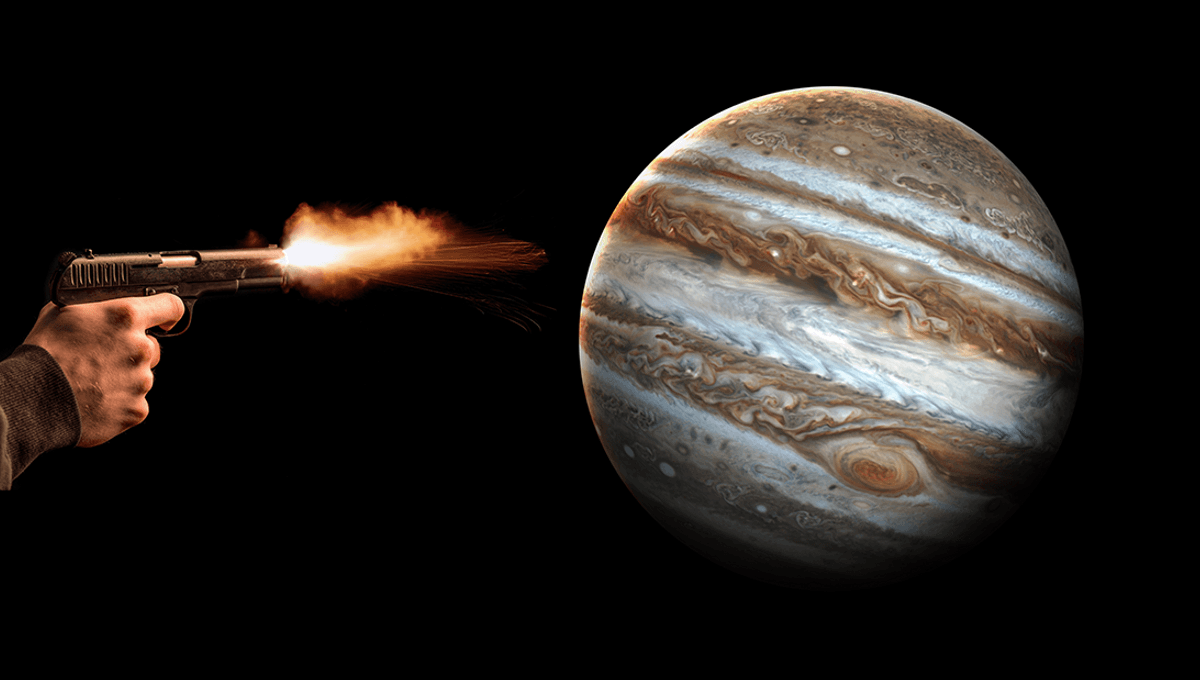
The four gas giant planets in the Solar System are Jupiter, Saturn, Uranus, and Neptune – and they are very alien to the experience we have here on Earth. They have thick atmospheres, unlike anything seen in the rocky planets of the Solar System. Some people wonder if passing through them would be a bit like going through a cloud, and the answer is no, unless the cloud you’re going through is a cloud of death and destruction.
This question is often boiled down to: “could you shoot a bullet through Jupiter?” After all, bullets are small and fast. The answer in almost every scenario is a disappointing no – but why it’s a no is actually very interesting. Understanding the interior of Jupiter is one of the scientific goals of the Juno mission, which has been studying the King of the planets for years. Using different instruments, the spacecraft is learning what’s going on inside the planet.
It’s important to know that Jupiter is not gas all the way through. No gas planet is. Jupiter has a core and a mantle underneath the atmosphere. The planet’s dense core has a somewhat fuzzy demarcation, mixing with the mantle above, a gigantic ocean of liquid metallic hydrogen. Metallic hydrogen is a peculiar state of hydrogen that happens at high pressures.
The gas will be liquified and it would look and behave like mercury, except that hydrogen is 60 percent as dense as water and it is under enormous pressure. No technology we possess could withstand that. This ocean is tens of thousands of kilometers deep and it is expected to extend to 80 percent of the planet’s radius. Precise measurements of the core are still needed, but its radius could extend up to half the whole radius of the planet.
So, we can’t go through the center of the planet. At most, we could consider shooting a bullet through the outer layers of the atmosphere of Jupiter. What we know about those regions is informed by both Juno and Galileo probes, but we also have insights thanks to the Cassini mission that went to Saturn and Earth-based observatories.
So, could you shoot a bullet through the outer layers of Jupiter’s atmosphere? Based on some simplistic approximation, to stay in orbit around Jupiter at the edge of the atmosphere, you’d have to be moving 42.5 kilometers (26.4 miles) per second. The fastest bullet on sale is 30 times slower than that.
And that’s just to stay around the planet – if you were to go through the planet, you’d be cooked first as the top of the atmosphere is at a whopping 900 Kelvins (630°C / 1,160°F). The temperature then drops, but wind speed and pressure start rising up. The Galileo Probe ended up surviving for 58 minutes, dropping 156 kilometers (97 miles) into the atmosphere, where it experienced a pressure of 23 atmospheres and a temperature of 153°C ( 307°F).
An average bullet is stopped by a couple of meters of water. What we would require to shoot this bullet is an enormous effort for little benefit. Unless you have an incredibly strong gun and you shoot at a very shallow angle, you won’t be getting through Jupiter. Not that Jupiter would notice – in fact, Jupiter has been hit by things moving much faster than even our idealized bullet.
In 1994, Comet Shoemaker-Levy 9 hit Jupiter at 61.4 kilometers (38.1 miles) per second. It left some marks in the atmosphere for a while, but particles released by the impact are still there and researchers have even used them to measure how fast the stratospheric winds of Jupiter are.
Source Link: Could You Shoot A Bullet Through Jupiter?